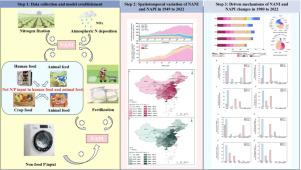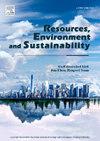揭示中国人为营养素投入的长期动态和时空驱动因素:饮食和社会经济因素的影响
IF 7.8
Q1 ENVIRONMENTAL SCIENCES
引用次数: 0
摘要
过去几十年来,发展中国家的人为营养投入在很大程度上影响了全球营养平衡格局,造成了富营养化和污染的扩大。社会经济因素和饮食习惯的巨大变化使得很难确定它们对营养平衡的具体影响。利用净人为氮(NANI)和净磷(NAPI)投入模型,计算1949 - 2022年中国人为氮(N)和磷(P)投入,并应用XGBoost-SHAP算法估算社会经济结构和饮食结构对二者的驱动力。研究结果表明,在1949年至2022年期间,两种养分投入均在2014-2015年达到峰值,然后下降,化肥施用是主要贡献者(氮占56%,磷占63%)。不同区域NANI和NAPI的演化模式存在较大差异。东部和南部省份(如河南、上海)的投入最高,而西部地区(如空间聚类)则突出了对区域特定营养管理战略的需求。饮食变化表明,动物性食品消费增加(增长6.89倍),城乡差距加大,发达地区的摄入量超过了建议水平。不同地区不同发展阶段的NAPI和NANI的驱动因素存在差异。在发达地区(第一类),城市化和GDP是主要驱动因素,而在欠发达地区(第二类),人口是主要驱动因素。这些发现强调了解决营养污染和饮食影响的量身定制政策的重要性,并为制定营养缓解战略提供了新的见解。本文章由计算机程序翻译,如有差异,请以英文原文为准。

Revealing long-term dynamics and spatiotemporal drivers of anthropogenic nutrients inputs in China: The effects of dietary and socioeconomic factors
Anthropogenic nutrient inputs in developing countries have substantially shaped global nutrient balance pattern for the past decades, responsible for the expanding eutrophication and pollutions. The massive alteration of socioeconomic factors and dietary habit make it difficult to identify their specific impacts on nutrient balance. This study utilized the net anthropogenic nitrogen (NANI) and phosphorus (NAPI) inputs models to calculate human induced nitrogen (N) and phosphorus (P) inputs in China from 1949 to 2022, and applied the XGBoost–SHAP algorithm to estimate the driving forces of socio–economic and dietary structure on them. Our findings revealed that both nutrient inputs peaked around 2014–2015 before declining and fertilizer application was the primary contributor (56% for N, 63% for P) from 1949 to 2022. Great variation of NANI and NAPI evolution patten was found in different regions. Eastern and southern provinces (e.g., Henan, Shanghai) had the highest inputs, while western regions (e.g., Tibet) had the lowest, correlating with economic and population density disparities. Spatial clustering highlighted the need for region–specific nutrient management strategies. Dietary shifts showed increased animal–based food consumption (6.89–fold rise) and urban–rural disparities, with developed regions exceeding recommended intake levels. Driving factors for NANI and NAPI differed by regions of different development stage. Urbanization and GDP were dominant drivers in developed areas (Type I), while population was key in less–developed regions (Type II). These findings underscore the importance of tailored policies to address nutrient pollution and dietary impacts, and provide new insights for formulating nutrient mitigation strategies.
求助全文
通过发布文献求助,成功后即可免费获取论文全文。
去求助
来源期刊

Resources Environment and Sustainability
Environmental Science-Environmental Science (miscellaneous)
CiteScore
15.10
自引率
0.00%
发文量
41
审稿时长
33 days
 求助内容:
求助内容: 应助结果提醒方式:
应助结果提醒方式:


